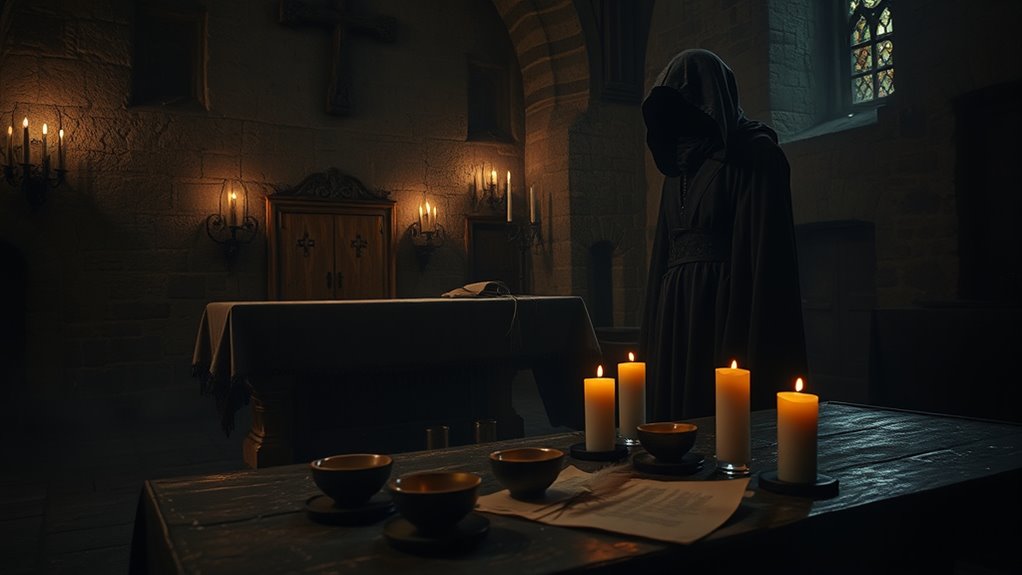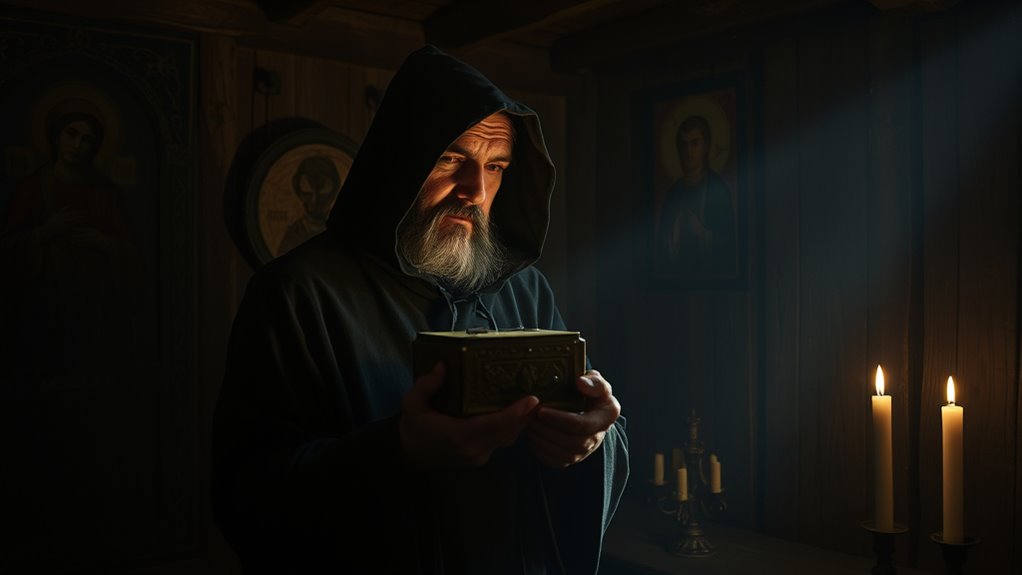In folklore, sin-eaters are people who take on the sins of the deceased, symbolizing communal responsibility and spiritual cleansing. This practice often involves rituals, offerings, or ceremonies that reflect themes of sacrifice and moral transfer. Origins trace back to rural England, where sin-eaters played a shameful but necessary role. Their meaning highlights how societies used these figures to cope with guilt, justice, and the afterlife. Continue exploring to uncover more about their historical and cultural significance.
Key Takeaways
- Sin-eaters are ritual figures in folklore who take on the sins of the deceased to grant them spiritual peace.
- Their origins trace back to rural England, where they were marginalized community members performing symbolic cleansing rites.
- The practice embodies themes of sacrifice, community responsibility, and spiritual purification within cultural beliefs.
- Sin-eaters serve as intermediaries, symbolizing the transfer of moral guilt and reinforcing notions of divine justice.
- Historically, sin-eating reflects societal ways of addressing guilt, morality, and the afterlife through ritual acts.

Sin-eaters play a fascinating role in folklore, serving as individuals who take on the burden of consuming a deceased person’s sins to grant them peace in the afterlife. This practice isn’t just about eating bread or drinking wine; it’s deeply rooted in ritual symbolism that signifies the transfer of moral guilt from the departed to the sin-eater. In many traditions, the act embodies the cleansing of the soul, allowing the deceased to move on without the weight of their sins. You might imagine this as a symbolic ritual where the sin-eater acts as a spiritual intermediary, embodying communal beliefs about justice, redemption, and the afterlife. The concept of sin-eating varies widely across different cultures, reflecting diverse understandings of morality, death, and spiritual purification. In some regions, the ritual involved a specific person, often a marginalized member of the community, who was called upon to perform the act. In others, the role was more formalized, linked to religious or spiritual practices that emphasized the importance of cleansing the soul. These cultural variations influence not only who performed the act but also how it was perceived by the community. For example, in certain parts of rural England, the sin-eater might have been seen as a necessary, albeit somewhat shameful, figure—someone who carried the community’s collective sins in a symbolic act. Conversely, in other cultures, the act of sin-eating was integrated into more elaborate ceremonies, sometimes involving offerings, prayers, or specific rituals that reinforced its spiritual significance. Ritual symbolism associated with sin-eating often highlights themes of sacrifice, community responsibility, and spiritual purification. The act itself is seen as a form of social and religious cohesion, where the community collectively acknowledges the burden of sin and seeks to restore moral balance. In some traditions, the sin-eater’s role was viewed as both sacred and stigmatized, reflecting a complex relationship between moral duty and social marginalization. Whether performed in private or public settings, the ritual served as a tangible expression of faith in divine justice, emphasizing that sins could be transferred and absolved through symbolic acts. Additionally, understanding cultural variations and the underlying ritual symbolism helps you appreciate the depth of the sin-eater’s role in folklore. It wasn’t just about the act of eating but about embodying a spiritual principle that transcended individual morality and reflected communal values. This tradition, though largely faded, reveals how different societies have historically grappled with notions of guilt, redemption, and the afterlife, emphasizing that these concepts are as diverse as the cultures that practiced them.
Frequently Asked Questions
How Did Sin-Eaters Originate Historically?
You might find that sin-eaters originated during medieval rituals, especially in rural England, where they played a role in cultural symbolism. People believed sin-eaters could absorb the sins of the deceased, providing spiritual relief. This practice allowed communities to handle death and morality through ritual, blending religious beliefs with local customs. Over time, these rituals became a symbolic act, reflecting society’s views on sin, redemption, and social cohesion.
Are Sin-Eaters Still Practiced Today?
You might think sin-eaters are just a thing of the past, but they’re not entirely gone. Today, some communities still practice ancient rituals, while others explore modern adaptations, like spiritual ceremonies or symbolic acts. However, contemporary perceptions often view sin-eating as a quirky tradition rather than a serious practice. While rare, these customs reveal how people try to cope with guilt and mortality, blending old beliefs with new cultural expressions.
What Rituals Are Involved in Becoming a Sin-Eater?
You participate in ritualistic ceremonies that involve symbolic acts when becoming a sin-eater. Typically, these rituals include reciting prayers or blessings, eating bread or food offered by the family, and sometimes drinking alcohol. These acts symbolize the transfer of sin, allowing the sin-eater to cleanse the departed’s soul. The ceremonies are deeply rooted in folklore, emphasizing community, spiritual cleansing, and the mystical connection between the living and the dead.
How Did Different Cultures Interpret the Role of Sin-Eaters?
Think of sin-eaters as bridges connecting worlds of morality and tradition. Different cultures interpret their role uniquely, shaping their moral implications. In some societies, they’re seen as compassionate healers, while others view them as necessary yet stigmatized figures. Cultural variations influence how they’re perceived—either as sacred mediators or as outcasts—highlighting how diverse beliefs turn this practice into a reflection of moral values and societal norms.
What Psychological Effects Did Sin-Eaters Experience?
As a sin-eater, you likely experience a heavy guilt burden and emotional trauma from absorbing others’ sins. This role can cause feelings of shame, isolation, and mental exhaustion, as you carry the weight of collective guilt. Over time, these psychological effects may lead to depression or anxiety, making it difficult to separate your identity from the sins you’ve taken on, ultimately impacting your well-being.
Conclusion
Just as a sin-eater takes on the weight of others’ guilt, you carry the echoes of their shame within you. Their burdens become your own, a silent dance of shadows and forgiveness. In this delicate balance, you become a keeper of secrets, a bridge between worlds of sin and salvation. Remember, every story of the sin-eater reminds you that sometimes, bearing others’ burdens is part of understanding the fragile dance of humanity’s darkness and light.









